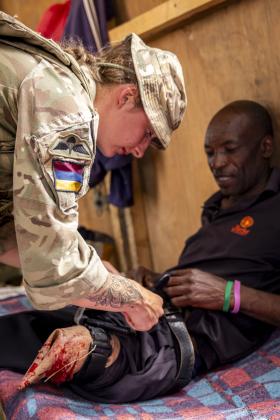An overnight march to attack an enemy position marked the end of a busy period of humanitarian operations and combat in East Africa, that has shown how paratroopers are "comfortable in chaos".
In April, the 3 PARA Battlegroup headed to Sudan, coming off a major exercise on Salisbury Plain, to provide security and logistic support to the evacuation of British civilians. On their return, troops rapidly reset to head out to Kenya for six weeks of training for high intensity warfare.
The demands placed on soldiers by these contrasting challenges reflects the nature of their role serving in 16 Air Assault Brigade Combat Team, the British Army’s global response force. The battlegroup is built around the airborne infantry of Colchester-based 3rd Battalion The Parachute Regiment, bolstered by artillery, engineers, signallers, medics, and logisticians, all specially trained and equipped to deploy by parachute, helicopter or airlanding.
Lieutenant Colonel Will Hunt, Commanding Officer of 3 PARA Battlegroup, said: “Sudan and Kenya were completely different situations, requiring different skills and mindsets. But in both situations what really stood out to me was every soldier’s willingness to work tirelessly to do what needed to be done and to be comfortable in chaos, which is what our role demands.”
The particular chaos that troops were trained for on Exercise Haraka Storm in Kenya was high-intensity combat, with the equipment and vehicles they would be able to deploy by air with on an operation.
Over a challenging six weeks troops started by polishing their individual skills, with infantry practising their patrolling skills by day and night, engineers building bridges and defensive positions, logisticians delivering supplies and medics how they would treat battlefield casualties.
The training then progressed through company-sized using live ammunition towards a final mission which saw the whole force operating together. The final challenge for paratroopers was a 16 mile (25km) overnight march to assault an enemy position at the top of a rocky outcrop.
“Kenya has been a real test for the battlegroup,” Lt Col Hunt said. “It has been hard soldiering with some testing problems to overcome, particularly given our approach of not making it easy for ourselves with a limited vehicle fleet meaning lots of long marches.
“The final attack was up perhaps the most challenging terrain I’ve ever seen, but the professionalism that soldiers showed at the end of a long, long night was humbling to witness. It may not have felt good at the time, but there was a huge sense of pride and achievement in having done something that a lot of other units would shy away from, but we need to be ready to do.”
As well as fighting an enemy force provided by 1st Battalion The Royal Irish Regiment, troops had to handle the environmental challenges of Kenya.
3 PARA’s Private Ryan Simpson said: “Kenya is an unbelievably tough place to operate. Firstly, it’s hot, every day is a hot sunny day, which takes some getting used to. Secondly, the terrain is really steep and the ground is baked hard, which is tough on your knees, elbows and hands. On top of all that, there’s animals to be aware of – we’ve seen hyenas, lions and elephants.
“I enjoyed the live firing the most, you get that authentic sense of battle using live ammunition which makes everyone that much more switched on. I’ve also been working as second-in-command of my section, and I’ve learnt a lot and built my confidence before I go on a promotion course.”
Under an agreement with the Kenyan Government, up to six infantry battlegroups per year carry out exercises in Kenya, to provide a stern test for units preparing to deploy on operations or assume high-readiness role.
Source:
MOD Army Press Office
Read More





Latest Comments
There are currently no comments for this content.
Add Comment
In order to add comments you must be registered with ParaData.
If you are currently a ParaData member please login.
If you are not currently a ParaData member but wish to get involved please register.